Brioche Sourdough Cinnamon Rolls
These brioche sourdough cinnamon rolls are super soft and fluffy, filled with sweet cinnamon sugar, and topped with a cream cheese glaze. They’re made with a buttery and soft sourdough brioche dough that becomes so fluffy and tender.

Brioche dough is extra enriched with a lot of eggs and butter. It’s a decadent dough that makes such delicious sourdough cinnamon buns. The brioche dough used in this recipe is based on my sourdough brioche bread, with a tweak in the timings.
I use a stiff starter in this recipe, but you can use a 100% hydration starter if you prefer.
Ingredients
The ingredient amounts for these sourdough brioche cinnamon rolls are listed in the printable recipe card at the bottom of this post. Here is just a rundown of what you will need.
- All-purpose flour or bread flour – This recipe works well with a strong all-purpose flour with around 11% protein.
- Active sourdough starter
- Granulated and soft brown sugar (for the dough and the filling).
- Large eggs
- Whole milk
- Vanilla extract and cinnamon
- Butter – this can be salted or unsalted butter. It’s used in the filling and the dough
- Salt
Equipment
- A stand mixer fitted with a dough hook will provide the easiest results.
- A 22.5 x 33cm / 9×13-inch baking tray to bake the sourdough cinnamon rolls.
Sourdough brioche dough
This dough is best mixed using a stand mixer as it can be quite tricky to work by hand. The dough is high in hydration and it’s sticky for a very long time until the gluten is developed enough. Therefore it needs a long period of kneading.
That being said, it’s absolutely possible to make it by hand as long as you’re not intimidated by wet dough, you can work the dough in fast movements and you have patience.
My brioche bread recipe has a video of the dough being worked by hand.

Baker’s schedule
Here is a rough outline of the baker’s schedule to get an idea of the timings.
- The night before – Feed your starter
- 9 am – Mix the dough
- 9:30 am – Let it rise in a warm spot until it has bulked out by half (approximately 4-6 hours, depending on the temperature)
- 1:30 pm – Refrigerate the dough overnight.
- After the cold rest – Shape the dough and let it rise a second time, around 2-3 hours. Then bake.
Method
The evening before
- Mix together 30g starter with 60g flour and 30g water. Knead it for a minute or two into a stiff dough ball.
- Place this into a lightly oiled jar. Brush the top of the ball dough with a little water (so it doesn’t dry out too much overnight). Loosely cover with a lid and leave it to rise for 8-12 hours until more than doubled and domed on top.

- In the morning, add the starter, flour, sugar, salt, eggs and milk to the bowl of a stand mixer fitted with a dough hook attachment. Turn the mixer on low and combine until it forms a thick and shaggy dough.
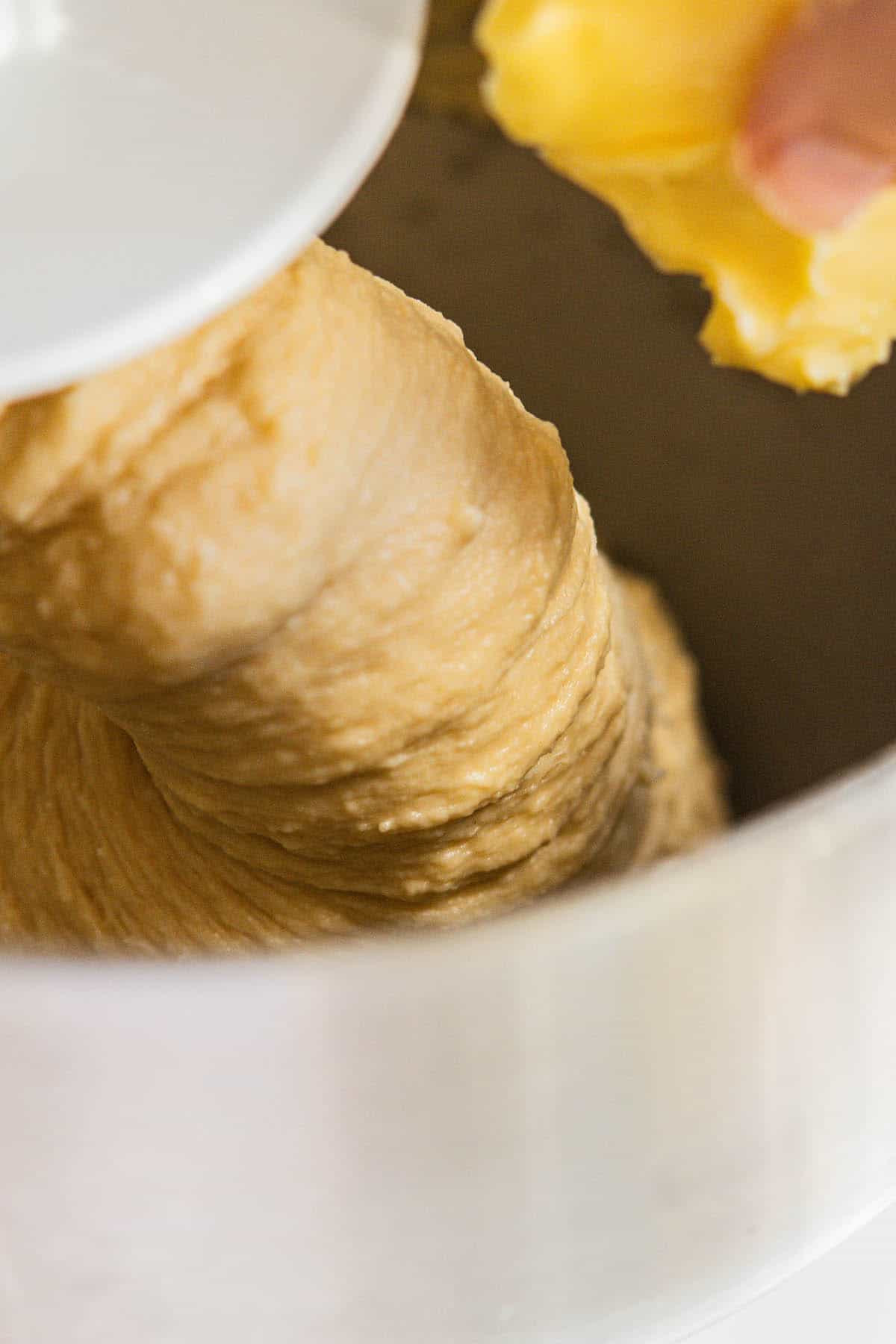
- Mix this dough on medium-low speed for around 5 minutes to begin developing the gluten.
- Add the softened butter to the bowl of your stand mixer, a little bit at a time.
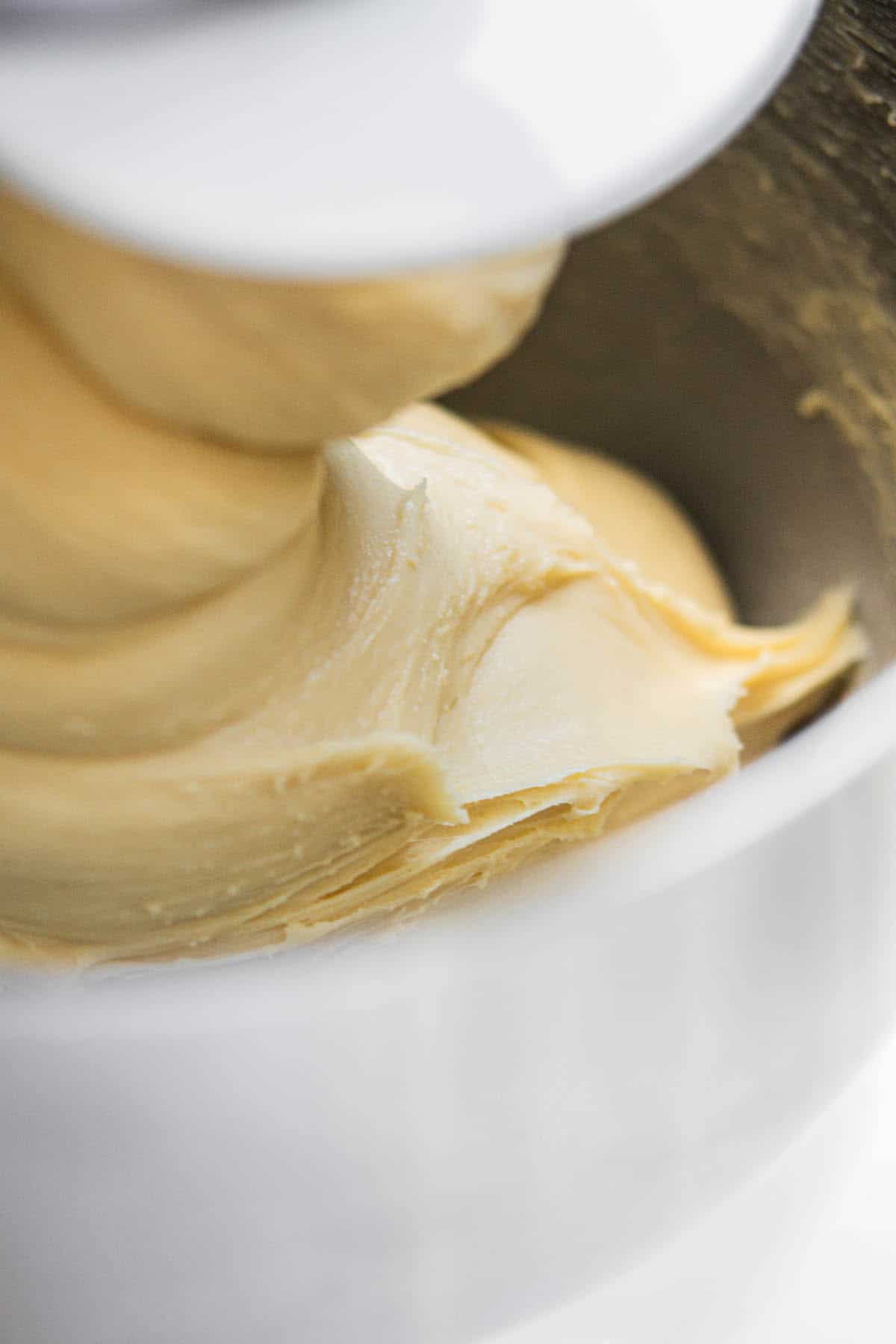
- Turn the mixer on medium speed and keep it mixing for around 15 minutes until the sticky and soft dough strengthens, comes together, and pulls away cleanly from the sides of the bowl.
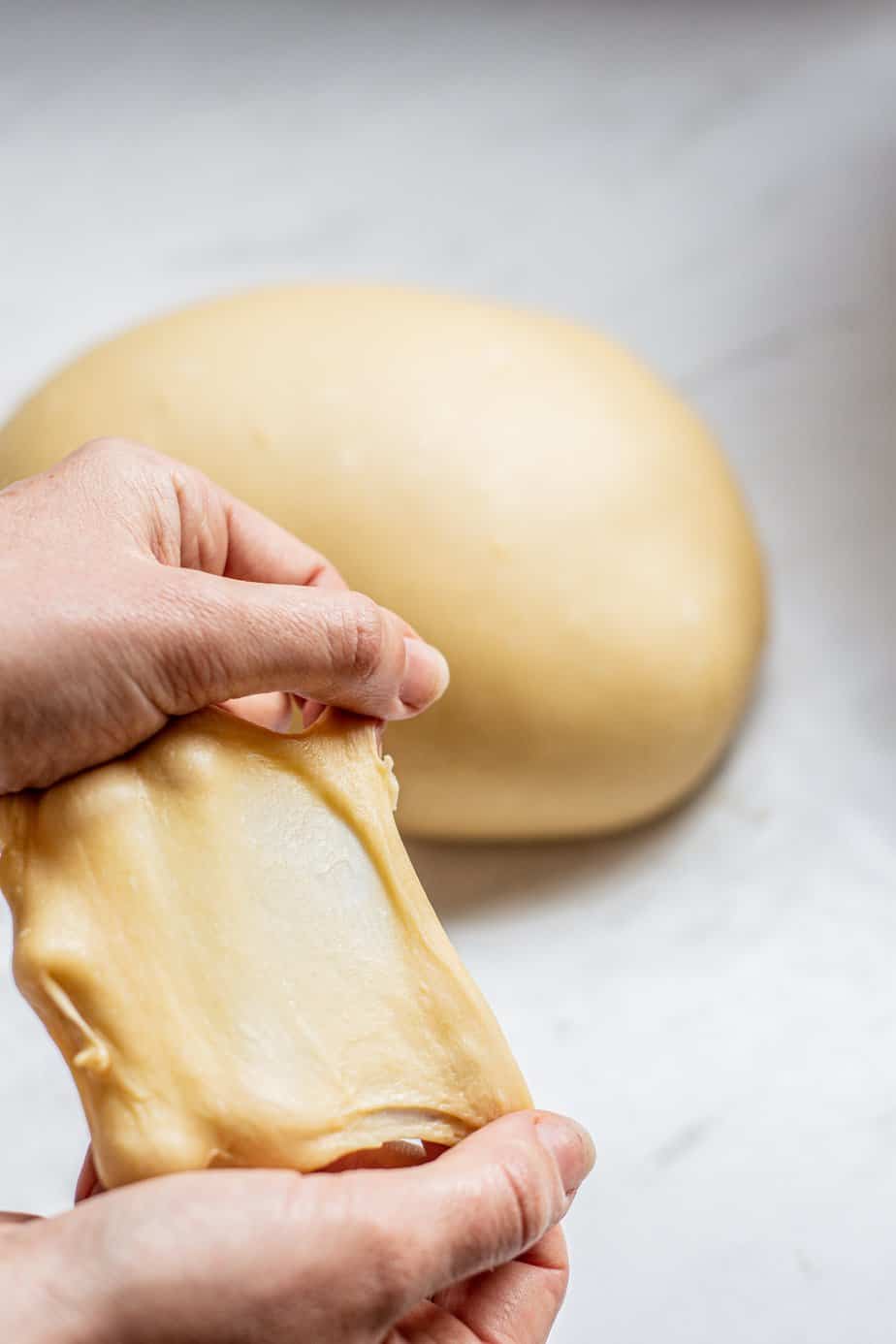
- Once finished mixing, leave the dough to rest for a few minutes, then grab a piece and see if you can stretch it out thin so it’s almost see-through, without tearing. This is called the ‘windowpane’ effect and shows proper gluten development.
- Once the dough is kneaded, shape it into a smooth ball and place it into a large greased bowl.
Bulk fermentation
- Cover with a damp tea towel, compostable plastic wrap, or lid. Place the dough in a warm place, ideally around 25°C / 76°F, and let it rise.
It won’t fully double in this first rise but should bulk out by at least 60%. This will take around 4-6 hours, but the rise time will change depending on the temperature. You can create a warm and humid proofing spot by placing a large mug of boiled water in a turned-off oven and putting the dough in there. Replace the water with freshly boiled water if it cools down.
- Once risen, place the dough in the fridge for at least 4 hours or up to 24 hours.
Shaping
- After the refrigerator proof, deflate and pull the cold dough from the bowl onto a lightly floured surface. Roll the dough out into a 30x45cm (12×18 inch) rectangle.
- Spread softened butter over the dough. Sprinkle cinnamon sugar over the butter. Tightly roll up the dough to form a 45cm/18-inch long log. Slice the log into 12 even-sized pieces. The unraveling end parts of each roll can be tucked under to keep them tight.
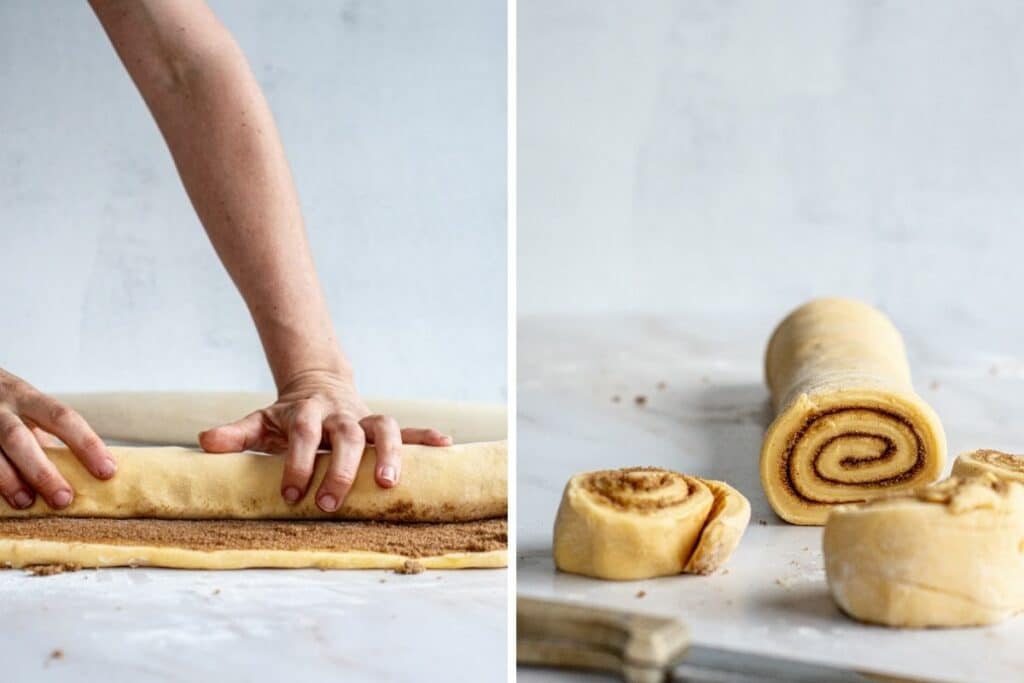
Proofing
- Grease a baking tray, place in the rolls, and cover them with a lightly damped tea towel to stop the tops from drying out too much. Let them rise in a warm spot until they double in size.

- Once risen, bake the rolls.
The cream cheese frosting
- Beat the cream cheese in a mixer until smooth and creamy. Add the confectioners’ sugar, vanilla, and milk. Beat it together until creamy.
- Spread the icing over the still-warm cinnamon rolls and serve immediately.
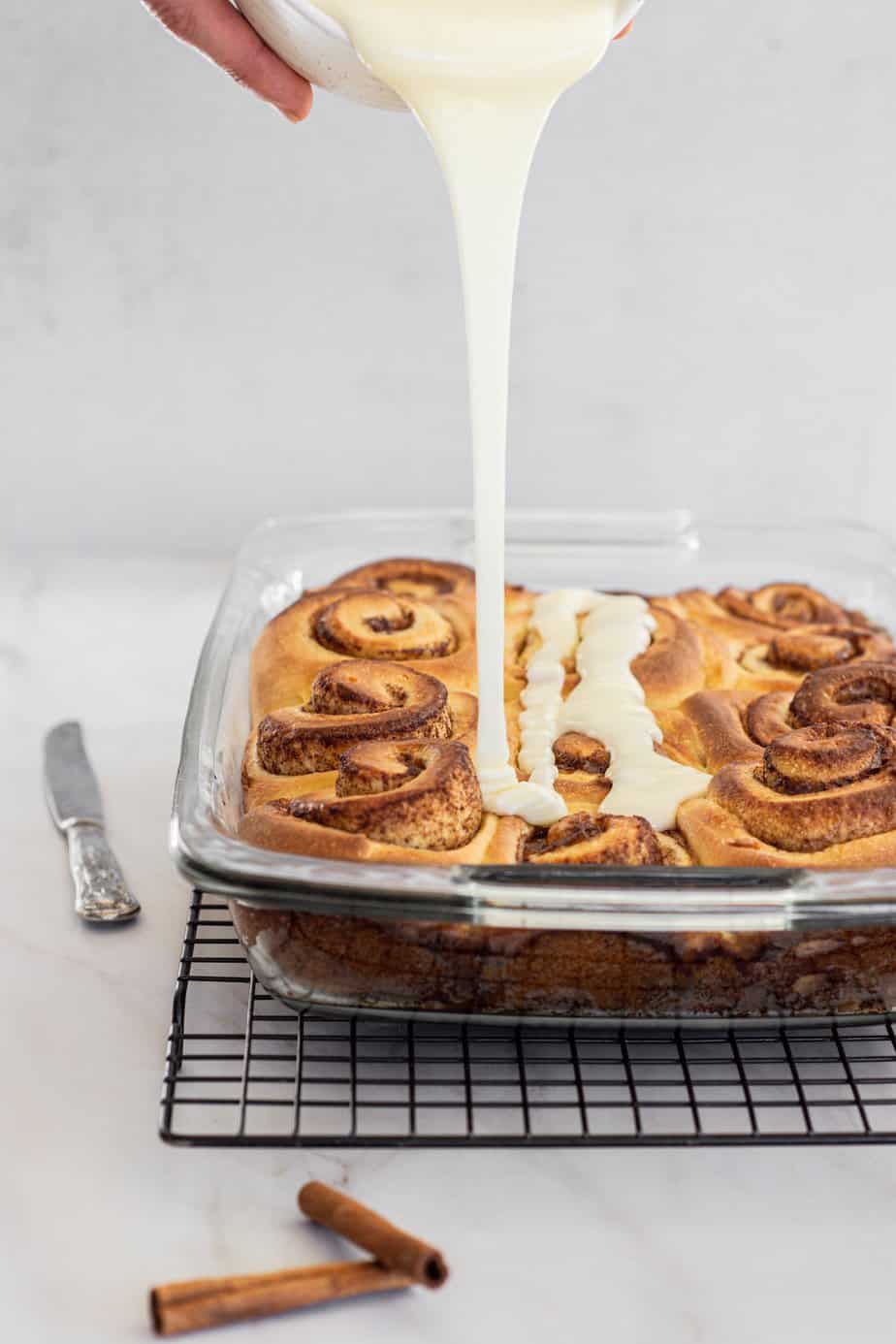
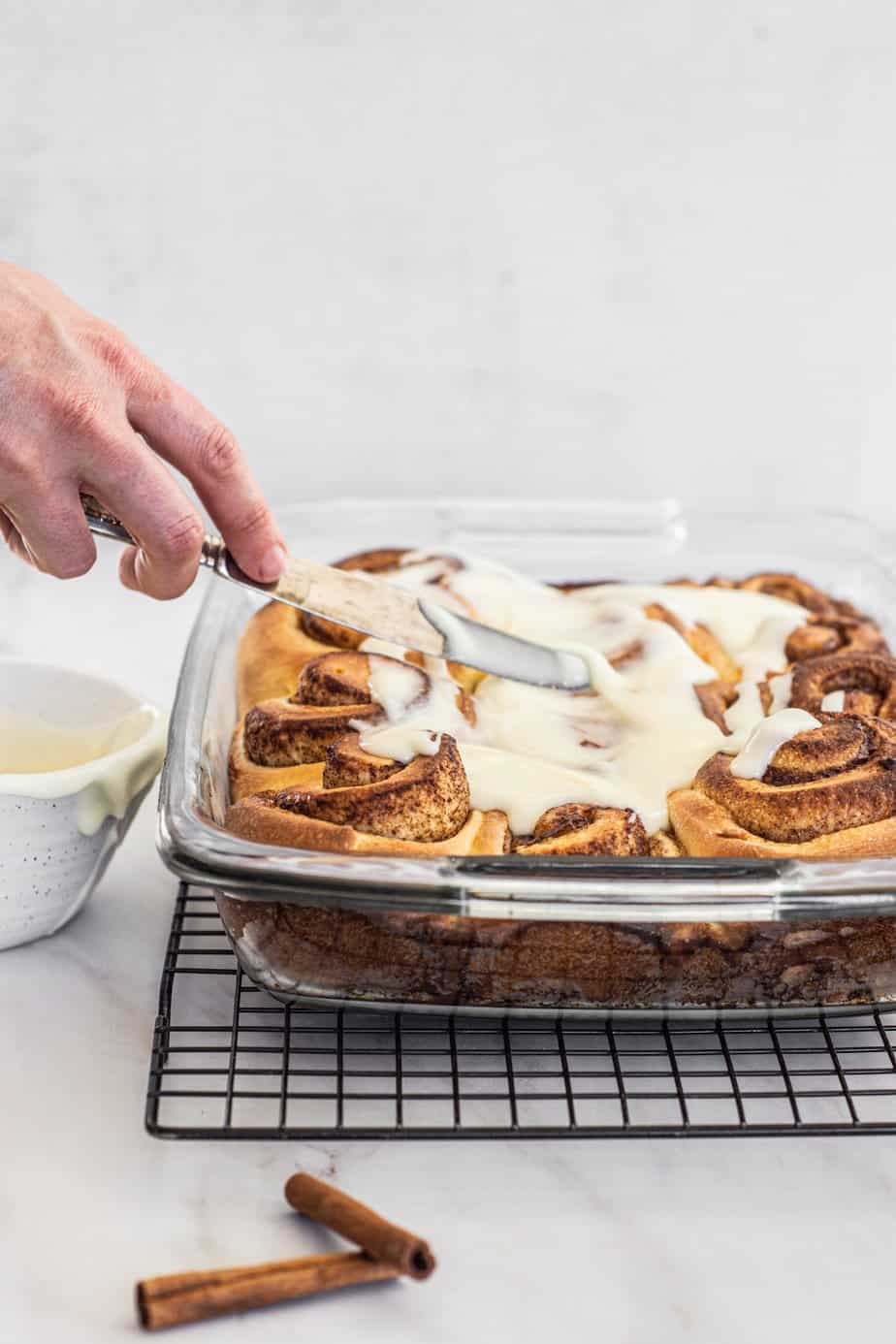
Storing
Leftover sourdough cinnamon rolls can be covered and stored at room temperature for up to 3 days. On the following days, they can be rewarmed and softened in the microwave.
Looking to make these without sourdough? Here is a brioche cinnamon roll recipe for that!
- Sourdough Monkey Bread
- Sourdough Blueberry Rolls
- Soft Sourdough English Muffins
- Sourdough hamburger buns


Brioche Sourdough Cinnamon Rolls
These brioche sourdough cinnamon rolls are super soft and fluffy, filled with sweet cinnamon sugar, and topped with a cream cheese glaze.
Ingredients
Stiff starter* (See notes)
- 30g starter
- 60g flour
- 30g water
Brioche dough
- 550g strong all-purpose flour with around 11% protein
- 50g granulated sugar
- 4 large eggs
- 125g milk
- All the stiff starter
- 8g salt
- 180g unsalted butter, room temperature, cut into cubes
Cinnamon filling
- 75g unsalted butter, softened
- 100g soft brown sugar
- 2 1/2 tsp ground cinnamon
Frosting
- 60g cream cheese, at room temperature
- 150g powdered sugar
- 2 Tbsp milk at room temperature
- ½ tsp vanilla extract
Instructions
The night before - Feed the starter
- Mix together 30g starter with 60g flour and 30g water. Knead it for a minute or two into a stiff dough ball.
- Place this into a lightly oiled jar. Brush the top of the ball dough with a little water (so it doesn't dry out too much overnight). Loosely cover it with a lid and leave it to rise for 8-12 hours until it is more than doubled and domed on top.
The next morning - The dough
- In the morning, add the starter, flour, sugar, salt, eggs, and milk to the stand mixer bowl fitted with a dough hook attachment. Turn the mixer on low and combine until it forms a thick and shaggy dough.
- Mix this dough on medium-low speed for around 5 minutes to begin developing the gluten.
- Add the softened butter to the bowl of your stand mixer, a little bit at a time.
- Turn the mixer on medium speed and keep it mixing for around 15 minutes until the sticky and soft dough strengthens, comes together, and pulls away cleanly from the sides of the bowl.
- Once finished mixing, leave the dough to rest for a few minutes, then grab a piece and see if you can stretch it out thin so it’s almost see-through, without tearing. This is called the ‘windowpane’ effect and shows proper gluten development.
- Once the dough is kneaded, shape it into a smooth ball and place it into a large greased bowl.
Bulk fermentation
- Cover with a damp tea towel, compostable plastic wrap, or lid. Place the dough in a warm place, ideally around 25°C / 76°F, and let it rise.
- It won’t fully double in this first rise but should bulk out by at least 60%. This will take around 4-6 hours, but the rise time will change depending on the temperature. You can create a warm and humid proofing spot by placing a large mug of boiled water in a turned-off oven and putting the dough in there. Replace the water with freshly boiled water if it cools down.
- Once risen, place the dough in the fridge for at least 4 hours or up to 24 hours.
Shaping
- After the refrigerator proof, deflate and pull the cold dough from the bowl onto a lightly floured surface. Roll the dough out into a 30x45cm (12×18 inch) rectangle.
- Spread softened butter over the dough. Sprinkle cinnamon sugar over the butter. Tightly roll up the dough to form a 45cm/18-inch long log. Slice the log into 12 even-sized pieces. The unraveling end parts of each roll can be tucked under to keep them tight.
Proofing
- Grease a baking tray, place in the rolls, and cover them with a lightly damped tea towel to stop the tops from drying out too much. Let them rise in a warm spot until they double in size.
- Preheat the oven to 375°F (190°C).
- Bake the risen buns for around 30 minutes until puffed up and golden brown. If they are browning too quickly, loosely cover them with aluminum foil.
The cream cheese frosting
- Beat the cream cheese in a mixer until smooth and creamy. Add the confectioners’ sugar, vanilla, and milk. Beat it together until creamy.
- Spread the icing over the still-warm cinnamon rolls and serve immediately.
Storing
- Leftover sourdough cinnamon rolls can be covered and stored at room temperature for up to 3 days.
- On the following days, they can be rewarmed and softened in the microwave.
Notes
I use a stiff starter because I think it gives a better rise. However, the stiff starter can be substituted with around 120 grams of 100% hydration starter
Nutrition Information:
Yield: 12 Serving Size: 1Amount Per Serving: Calories: 493Total Fat: 21gSaturated Fat: 13gTrans Fat: 0gUnsaturated Fat: 7gCholesterol: 114mgSodium: 314mgCarbohydrates: 65gFiber: 2gSugar: 26gProtein: 10g






This recipe looks lovely, have you tried freezing them before baking? I am interested in making a larger amount to freeze and then be able to defrost a few at a time.
Heya, yup you can freeze the unbaked rolls. I would let them proof before freezing them, then you can bake them once thawed :).
Tried this recipe. It’s ok. The texture was lovely soft right out of the oven, but the rolls seem to dry out very quickly. Also, I’m not sure if it’s the process or starter, but my rolls came out pretty sour, which threw me off. I think if I try this recipe again, I might use less starter and a buttercream frosting to counter the sour flavor.
Hey Elle,
The rolls are definitely best served warm from the oven as brioche bread does tend to try out a bit on following days. Popping the rolls in the microwave for 15-20 seconds can soften them back up though. As for the sour flavor, these rolls have a long rising time so it can be quite pronounced. You can try control the tang a bit by adding a little sugar, a teaspoon or two to to the stiff starter as you mix it, and lessen the seed starter amount in the stiff starter mixture. For example 20g starter, 80g flour, 40g water and 5g sugar.
Can you use Einkorn flour? If so are any adjustments needed?
I have never used einkorn flour for this recipe sorry so I’m not sure
Hi Eileen, I am trying to plan ahead for these at a friend’s birthday breakfast. We are staying away the night before. So, if I was to freeze once shaped, then remove from freezer just before we leave, say 2pm. Would they thaw, then rise overnight ok to bake in the morning? If i froze after the rise and then take frozen they would probably be deflated by the morning, i think. Hope this makes sense.
Thanks
😊
Hey Katie,
I’ve not tried that before so I can’t say for sure that it would work, I think that would be okay! It’s how I would try to do it too 🙂
What temperature do you bake at and for how long?
Hey Nina, sorry I accidentally deleted that line when I edited the this post the other day! 375°F (190°) for around 30 minutes until puffed up and golden brown. If they are browning too quickly, loosely cover them with aluminum foil.
I have a question. What do I do if I don’t get the recipe started in time. I made the thickened/sweetened starter from my mature sourdough starter last night then didn’t get the time today to begin. Do I feed that starter again? And hope to begin in the morning?
Hey Michelle, yes I would feed it again in the evening and start in the morning